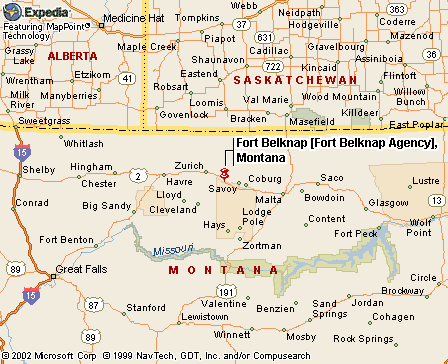|
|
Canku Ota |
|
|
(Many Paths) |
||
|
An Online Newsletter Celebrating Native America |
||
|
October 18, 2003 - Issue 98 |
||
|
|
||
|
Tribal Radio Station Plays On |
||
|
by Ron Selden
Indian Country Today
|
||
|
credits: Will
Gray Jr., who manages the only tribally owned public radio station
in Montana, said providing continuous service to area residents
is a primary goal of the station. (Photo by Ron Selden)
|
|
That's because most listeners aren't accustomed to hearing a steady mix of tribal news, Native commentary and pow wow drumming and singing transmitted year-round, 24 hours a day, seven days a week. The station, an affiliate of National Public Radio, American Indian Radio on Satellite and a member of the Corporation for Public Broadcasting, as well as the Native American Public Radio Consortium, is inconspicuously based in a little wooden building here behind White Clay Hall at Fort Belknap College. A major claim to fame is that KGVA is the only Native-owned and operated public radio station in Montana, the nation's fourth largest state. There are only 30 similar operations across the country, including Alaska and Hawaii. Motorists traveling nearly two hours away from the station, whose call letters represent the host Gros Ventre and Assiniboine tribes, can still pick up its 90-kilowatt signal. Manager Will Gray Jr. said KGVA's broadcast covers nearly 9,500 square miles that are home to four American Indian tribes, five Hutterite colonies and thousands of other residents scattered along southern Saskatchewan and the U.S. Canadian border. While passersby might find the unusual programming a novelty, area residents depend on the station as a crucial link to the outside world. With most other media outlets many miles away, KGVA serves a dual niche - keeping locals apprised of area happenings and bringing in programs such as "Native America Calling," billed as the world's "first electronic talking circle." Award-winning moderator Harlan McKosato notes that the popular call-in program is the only nationally syndicated American Indian radio talk show. Among many favorites at KGVA is "National Native News," which is also a production of the Alaska-based Koahnic Broadcast Corp. The tribal station's wide range of memberships and affiliations allows for a lively on-air montage, but Gray and Fort Belknap College President Carole Falcon-Chandler note that keeping the doors open is an all-consuming affair. "It's killing our budget, but we don't plan on closing it down," Falcon-Chandler said. "It's too important." According to Gray, it takes about $130,000 a year to keep the station afloat, and that's only with a skeleton crew of one full-time manager, two part-time announcers and a batch of volunteers. The days are long, the pay is short, but the satisfaction of serving the tribal and non-tribal public seems to be the glue that holds it all together. "The volunteers keep us open," Gray said, adding that the station must broadcast at least 18 hours a day to keep its public accreditation. "They're sometimes hit-or-miss, but they're something we rely on." The college provides space for the station and other support, and local underwriting brings in between $6,000 and $7,000 a year for operations, Gray said. Even though many area residents are mired in poverty, KGVA hopes to soon start semi-annual fund-raisers throughout the listening area to help pay the bills. "I think people want to keep this going," he said. "I hope they do." Gray, 29, is into his second year as manager. He had never worked at a radio station before and was KGVA's only employee the first six months of his tenure. A member of the Fort Belknap Indian Community, his professional background, in fact, is in natural resources. "I was doing the automation, the repairs, everything," he said of those harrowing first days on the job. "I guess I just had the drive to do that." Fortunately, much of KGVA's broadcasting is automated, which decreases the need for a lot of personnel. Nonetheless, Gray acknowledges it's largely been trial by fire so far. "We're putting in a lot of extra hours to keep it going," he said. "We try to do as much local programming as possible, but it's difficult to find people to do that. One community member plans to start covering tribal council meetings as a volunteer. We're always looking for other volunteers." Gray's also been working with high school students in nearby Harlem and Hays in hopes of sparking their interest in public communications. The station gets occasional work-study students from the college, but on-air help is often hard to find. "The (microphone) scares them off," Gray said. "They don't want to talk on the mic." |
|
|
www.expedia.com |
|
|
||
|
|
||
| Canku Ota is a free Newsletter celebrating Native America, its traditions and accomplishments . We do not provide subscriber or visitor names to anyone. Some articles presented in Canku Ota may contain copyright material. We have received appropriate permissions for republishing any articles. Material appearing here is distributed without profit or monetary gain to those who have expressed an interest. This is in accordance with Title 17 U.S.C. Section 107. | ||
|
Canku Ota is a copyright © 2000, 2001, 2002, 2003 of Vicki Lockard and Paul Barry. |
||
 |
 |
|
|
The "Canku Ota - A Newsletter Celebrating Native America" web site and its design is the |
||
|
Copyright © 1999, 2000, 2001, 2002, 2003 of Paul C. Barry. |
||
|
All Rights Reserved. |
||
 FORT
BELKNAP, Mont. - Travelers in the Hi-Line region of north-central
Montana are often surprised when KGVA-FM pops up on their radio
dial.
FORT
BELKNAP, Mont. - Travelers in the Hi-Line region of north-central
Montana are often surprised when KGVA-FM pops up on their radio
dial. 